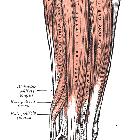Musculus extensor digitorum

Extensor digitorum (ED) muscle, also known as extensor digitorum communis (EDC) muscle, is a muscle of the superficial layer of the posterior compartment of the forearm and with other extensor muscles arises from a common tendon attached to the lateral epicondyle of the humerus. It is one of the extrinsic muscles of the hand. ED represents a medial group of superficial extensor muscles. ED passes under the extensor retinaculum which holds it tight and passes through the 4extensor compartment of the wrist, once it passes under the sagittal band of the metacarpophalangeal joint the tendon splits into three 'slips' consisting of two lateral slips and a central slip. The lateral slips, run both sides of the proximal interphalangeal joints to then converge with the intrinsic muscles of the hand to form a conjoint tendon, that inserts at the dorsal aspect of the base of the distal phalanx. The central slip inserts at the dorsal surface of the base of the middle phalanx.
Summary
- origin: lateral epicondyle of humerus
- insertion: middle, distal phalanges on posterior surface; extensor expansions of digits 2-5
- arterial supply: radial recurrent artery, posterior interosseous artery
- innervation: posterior interosseous nerve (C7, C8), a continuation of the deep branch of the radial nerve (C7, C8)
- action: extension in metacarpophalangeal joint
Siehe auch:
und weiter:

 Assoziationen und Differentialdiagnosen zu Musculus extensor digitorum:
Assoziationen und Differentialdiagnosen zu Musculus extensor digitorum:

